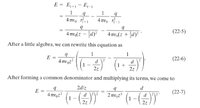You are using an out of date browser. It may not display this or other websites correctly.
You should upgrade or use an alternative browser.
You should upgrade or use an alternative browser.
Finding a common demominator
- Thread starter rtareen
- Start date
Steven G
Elite Member
- Joined
- Dec 30, 2014
- Messages
- 14,603
We do not do step by step here as that will be doing the work for you. This is a math help site! We expect you to do the work with our help.
Let's just talk about the two fractions being subtracted inside the big parenthesis. What is the common denominator? What is (1 - d/2)*(1+d/2)? So what will (1-d/2)2*(1+d/2)2 equal?
Let's just talk about the two fractions being subtracted inside the big parenthesis. What is the common denominator? What is (1 - d/2)*(1+d/2)? So what will (1-d/2)2*(1+d/2)2 equal?
ok. Since the fractions are so big ill do the numerator and denominator seperately.
first the common denominator will be
denominator = ((1-d/2z)(1+d/2z))^2 = (1 - (d/2z)^2)^2, which is the denominator we want.
The numerator on the left becomes (1 + d/2z)^2 = 1 + d/z + d^2/4z^2
The numerator on the right becomes (1 - d/2z)^2 = 1 - d/z + d^2/4z^2
Now since there is a common denominator we can subtract the numerators.
numerator = 1 + d/z + d^2/4x^2 - 1 + d/z - d^2/4z^2 = 2d/z
numerator/ denominator = (2d/z)/((1 - (d/2z)^2)^2)
first the common denominator will be
denominator = ((1-d/2z)(1+d/2z))^2 = (1 - (d/2z)^2)^2, which is the denominator we want.
The numerator on the left becomes (1 + d/2z)^2 = 1 + d/z + d^2/4z^2
The numerator on the right becomes (1 - d/2z)^2 = 1 - d/z + d^2/4z^2
Now since there is a common denominator we can subtract the numerators.
numerator = 1 + d/z + d^2/4x^2 - 1 + d/z - d^2/4z^2 = 2d/z
numerator/ denominator = (2d/z)/((1 - (d/2z)^2)^2)

